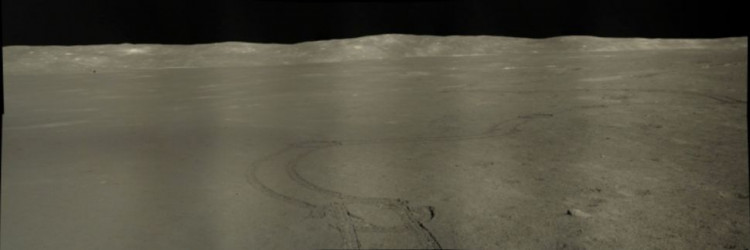China's Yutu 2 rover has returned a perspective of its journey through the harsh environment of the moon's far side after three years of travel.
The latest images, which were posted in late February by Ourspace, a Chinese language science outreach channel associated with the China National Space Administration, show the rover's winding path. One photo shows a panoramic view of Yutu 2's most recent tracks, with the Chang'e 4 lander visible in the distance.
Yutu 2 landed atop the Chang'e 4 lander on the lunar far side in January 2019, making the two the first spacecraft to land and operate on the moon's hidden hemisphere.
According to recent data from China's Lunar Exploration Ground Application System, the roughly 310-pound (140 kilos) solar-powered Yutu 2 has traversed 3,376 feet (1,029 meters) across Von Kármán crater since the duo landed.
Yutu 2 recently visited a crater rim to investigate a "mystery hut" observed on the horizon (which turned out to be a rabbit-shaped rock). From this vantage point, Yutu 2 can see sections of the tracks it has made in the lunar regolith, as well as its distant lander buddy down on the crater floor off to the left in the new panorama.
During its mission, the rover has discovered a variety of things, including debris that could be from beneath the moon's crust and glass spheres that were likely formed by meteor impacts.
Glass isn't uncommon on the moon, as it turns out. The substance occurs when silicate material is heated to a high temperature, and both of these elements are readily available on the moon.
These spherules could contain information about the moon's past, such as the composition of its mantle and impact events. Despite the fact that Yutu 2 was unable to collect compositional data, these natural lunar marbles could be intriguing research topics in the future.
Meanwhile, Yutu 2 has been tracked from orbit by NASA's Lunar Reconnaissance Orbiter (LRO). A collection of images from LRO camera websites depict the landing spot and the rover's journey across the surface over time.
Mark Robinson, an Arizona State University professor of geological sciences and the main investigator for LRO's imaging system, posted time-lapse imagery of the rover's trip to the northwest in late 2020.
Both the Yutu 2 and Chang'e 4 probes have four science payloads and have beyond their design lives of three months and one year, respectively. Each functions for about two Earth weeks when the sun shines, then powers down to withstand the long, frigid lunar night. The 40th lunar day of the mission began on February 23 and is anticipated to end on Wednesday (Mar. 9).




